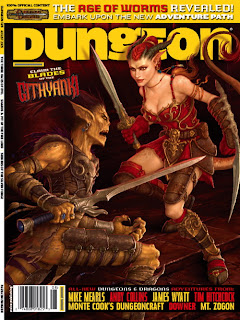 |
| GameMastery Guide |
I hesitated to purchase Paizo's
GameMastery Guide when it came out last year. I thumbed through the pages and nothing immediately leaped out at me. It has a lot of good info for novice game masters and all sorts of tables and info, but nothing that seemed like I really needed. The book's authors/designers had consciously tried to make an effort for their work to offer the kind of catch-all material found in Gary Gygax's
Dungeon Masters Guide for Advanced Dungeons & Dragons, published over 30 years ago. I'll say this - they did a great job of marrying that concept to the conciseness of the D&D 3.X core rulebooks. However, I felt there was nothing new under the sun for me there.
Well, I was wrong.
I finally got a copy of the book once I realized it had a full-blown NPCs gallery - over 50 pages of them. Each page has a NPC archetype - warrior, knight, bandit, slaver, assassin, thug, cultist, guild master, pick pocket, etc - with full stats and plenty of suggestions for tweaking combat abilities and the like. They run the gamut of challenge, from low to high level, with about three NPCs of various power levels fitting in with a general theme, such as criminals, aristocrats, city watch, and crusaders.
I realized this would be a great tool for a lot of situations, but I like it most because it would save me time on putting together my villainous humanoid leaders and followers - ie. orcs, goblins, etc. These guys, of course, have core stats in the Bestiary, typically as Warriors (NPC fighting class that is substandard to the more practiced Fighter). Now with just a few tweaks I can turn those human nefarious types into monster commanders and champions.
It's already proven some value in getting me a low-level cleric into our group of heroes, and on very short timetable. I made a tweak here or there, but it took me nothing like the time it would to start from scratch.
Then of course, there's the treasure tables. This is another time saving set of tools that has always been a part of the game. You don't really need the tables to sort out a good treasure mix for your players, but they make things so easy.
And for advice - well, I haven't read the entire book yet - but I have already found one gem that suggests really giving a memorable scene to one particular treasure - either its appearance and/or the circumstances of its discovery. Description and atmosphere are good for bringing an imaginary place to life for each player, but too many special events and they lose their uniqueness. I have to agree, and I used it to good advantage in the start up of a new campaign. One player discovered a small bag of garnets inserted into the crack of a cavern wall. That little treasure comprised about 5% of the total value of the adventure's haul, but they remember it as much as a truly special (and creepy) medallion found in the same adventure.
I highly recommend the book if you are playing Pathfinder or D&D 3.5 (Pathfinder is backwards compatible).
 |
| DM's Guide - TSR, 1979 |


















































